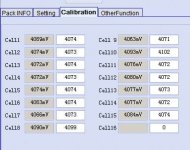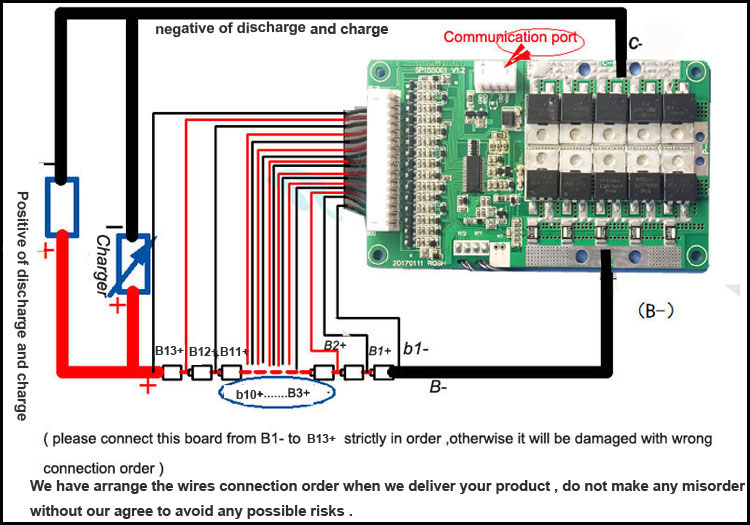izeman said:
madin88 said:
Thats the reason why P- is connect to Drain of it's belonging FET's, and C- is reverse connected to Source on the second group of FET's.
afaik a FET doesn't care about the direction the current goes. that's why you can use regen on your controller. the output FETs become input FETs during regen.
Yes correct...mosfets are not a diode junction like bipolars are. Current can flow in the mosfet junction in either direction.
Only enhanced mode mosfets have a back diode. Mosfets without diodes are readily available, but for uses on inductive loads, that diode is important. For a BMS, it could be either type of mosfet used, but with enhanced mode mosfets being soooo common and cheap, they commonly get used in BMS's. As a result the orientation of the mosfet is important so that the back diode does not effect shutting off current flow. IE: C- mosfets have their diodes reverse biased when charging from C-. From P-, current flow into the BMS if the mosfets are off is always possible since the back diodes are forward biased. However current flow out of the BMS if the mosfets are off is stopped since the back diodes are reverse biased. Effectively what this means is from P- you can't stop charging current only discharging current flow.
On the subject of over charging cells, I have yet to see this happen if I'm using a BMS. My chargers are always set to the pack full voltage. Let's say I have a 20S LIPO pack, fully charged at 4.1 volts per cell...since I use LION BMS's. That's 82 volts at 20S. With my charger set to 82 volts, and the pack nearing 82 volts, current draw from the charger drops off to nearly zero. At this point, it's only the low cells that are still taking current. All the fully charged cells are basically maintaining balance and that's all. I've checked this action many times and I just don't see cells getting beyond their balance voltage or 4.1 volts by more than .025 volts at most. The concern about using C- or not IMHO is completely unfounded.
I bet I could go to one of my EV's right now and run it down to my controllers LVC cutoff voltage which if I remember correctly is something like 3.1 volts per cell. I haven't watched charging action in many months so this is a good test and proof of what I have observed the last time I checked. I could connect up the correct charger and then charge the EV. I could check the cells one by one with my DMM and confirm what I just said. It is possible that some cells will charge to full sooner than others. BUT!!! As the entire pack gets close to fully charged total current draw from the charger drops off rapidly since the voltage difference between the charger and pack is so small. At this point, the high cells stay at their 4.1 volts (balance voltage thanks to the BMS balancing) and the low cells continue taking current. The over all effect at the charger is maybe .5 amps or less current draw spread across all the cells in the pack. This is well within the abilities of most balancing circuits to deal with at 16-20S. Watching the cells, I see the low cells still taking current (cell voltage continues to rise in the low cells) while the full cells are essentially maintaining balance voltage. The charged cells will rise to 4.125 volts and then drop back down when the balance circuit kicks in to bring them back down. This is typical BMS and RC charger behavior. They slightly over charge the cells on either side of a low cell and then discharge them. This action repeats until the low cell is up to full voltage. This is the action that I observe when I've checked charging and bringing up a low cell.
To get a result where high cells are over voltage would require that a cell was nearly dead flat. Lets assume a 20S pack charged to 82 volts with a cell at 2 volts. That means 2.1 volts is spread among 19 other cells or .11 volts over. With LIPO, where fully charged is 4.2 volts, this doesn't even constitute a concern at 4.21 volts per cell. With LION, it's more of a problem, but a battery fire is highly unlikely. If the BMS is working correctly, it would have long since reacted to this situation during pack discharge. When that one low cell dropped below the low voltage threshold it would have shut off the P- mosfets. IE: It would NOT have gotten to 2 volts before the BMS reacted. I've had this happen. I had a 20S, 20,000mah pack made of 10,000mah 4S multistar packs. A single cell was defective in one of the 4S packs. It had maybe 5000mah of capacity. AS a result that cell dropped below minimum voltage much faster than the rest of the cells in the pack. The BMS turned off the P- mosfets. I got home, opened up the EV to see what happened and checked all the cells and discovered that they were all at 3.8 or 3.9 volts except one which was at 3.2 volts. I then charged the entire pack and watched all the cells. The low cell increased in voltage, but of course when all the other cells were back to 4.1 volts, it was still at something like 3.8 volts. Current draw at the charger at this point was quite low...less than .2 amps. I periodically checked cell voltages and no cell got above 4.125 volts. The low cell eventually rose to 4.1 volts several hours later. After that I kept an eye on this weak cell and eventually pulled apart the pack after another 10 or so charges. My over all range thanks to the weak cell was reduced by about 30% when the BMS would cut out. Who knows why that cell had randomly died prematurely. I was never concerned about plugging in and walking away.
So then, lets talk about drastically BAD cell voltages for a minute. I'm sure NOT perfect and sometimes I do stupid stuff and kick myself really hard for it. This was at 12S and 48 volts. I was a noob to EV's. I had built 4 12S LIPO packs and was using a crappy charger that topped out at 52 volts. That's 2 volts over 4.2 per cell or 50.4 volts. This was not ideal for my LIPO packs and I had to watch that the voltage at the EV never went above 50.4 volts...or at least not by much. Charging over night was out of the question as all of the current from the charger would get spent in lots of balance circuits among 4 BMS in parallel and I'd possibly over charge my 4 12S packs. Fortunately the charger was capable of 2 amps so this wasn't a huge concern if I was watching the charge process periodically. I had purchased 3 BMS and they were in active use, but my 4th pack was waiting for it's BMS to arrive. It was common that I would plug in the charger into the EV and a couple of cell monitors into the unprotected pack. When the loud beeping started, it was time to pull the unprotected pack and finish charging via my RC charger. For whatever dumb reason, I flat forgot to do this. As you can imagine, that 12S pack was sitting at 52 volts or 4.33 volts per cell when I realized my mistake. I was thinking to myself why wasn't I hearing the cell monitors? I immediately realized it was becasue I had never plugged them in. I ran to the scooter and sure enough, every cell in that pack was at 4.3 volts and the pack was quite hot. I pulled it from the scooter, left it in the middle of the floor in my garage and let it cool down. All the cells now showed 4.4 volts!!! I then attached a load and pulled them back down to 4.1 volts per cell. That pack did suffer some loss of capacity, but no cell exploded or even puffed up. 2 weeks later it had it's own BMS. The other 3 12S packs that had BMS's were just fine. The cells despite the charger producing too much voltage were all sitting at 4.2 volts and soon were back down to 4.1 volts thanks to the LION BMS's.
A friend of mine was running with no BMS on 2 12,000mah 6S Multistar packs. I told him he really ought to invest in a 12S BMS, but he was cheap. One day, he forgot to charge and of course his EV didn't have a watt meter so he had no clue how low his LIPO packs were getting. He was close to home and the scooter felt super laggy, but he road home anyway. When he got home the LIPO packs were pretty hot...145F. He checked the voltages on them and one cell was at 0v and several others were at 1-2 volts. I think the highest cell was 2.6 volts. He asked me about what to do since it was pretty obvious that he had damaged his 2 LIPO packs. I told him how to recover low LIPO cells, but he was afraid of a battery fire. I got the 2 packs from him and proceeded to charge them. It's pretty easy to bring a low cell back to minimum voltage so that it can be charged normally. I've done it at least 50 times with 18650 cells scavenged from laptop packs. Now I was doing it for his really abused LIPO packs. All cells including the dead flat one came back up to full charge. It was badly bloated and when I tested it, had lost 80% of it's capacity. I pulled the cell and now had a 6S and 5S pack for free. I told my friend that I had recovered his packs, but he was afraid of them and let me keep them. They've seen use many times since then with no issues.



